Abstract
Since oxidative stresses are involved in gastroenteritis and diarrhea, we investigated antioxidative and antidiarrheal activities of persimmon flesh extract (PFE) and persimmon calyx extract (PCE) in vitro and in vivo, respectively. PCE significantly scavenged 1,1-diphenyl-2-picrylhydrazyl hydrate and 2,2'-azinobis (3-ethylbenzthiazoline-6-sulfonic acid) from 500 µg/mL, although PFE was ineffective. In addition, PFE and PCE exhibited strong nitric oxide-scavenging effects from 1 µg/mL, in which PCE was superior to ascorbic acid (50 µM). Furthermore, PFE and PCE significantly inhibited FeCl3-induced lipid peroxidation as well as Cu2+/H2O2-induced protein oxidation from 10 µg/mL. In vivo charcoal-propulsion assay, in contrast to a negligible effect of PFE, treatment with PCE (160–500 mg/kg) markedly inhibited intestinal motility. The results indicate that extracts of persimmon, especially PCE, possess antioxidative, antiinflammatory and antidiarrheal activities. Therefore, it is suggested that persimmon extracts could be used for the relief of gastroenteritis and diarrhea.
References
Bae, Y.-S., Lee, S.-C., Lee, W.-J., Kim, K.-J., Yoon, S.-W., Yoon, Y.-K., Yoo, J.-S., Park, H.-K. and Ha, W.-H. (. 1996. ). Effects of sports-drink with vinegar on physiological factors during exercise and recovery phase. Kor. J. Sports Med. 14(2):309–328.
Blois, M.S. (. 1977. ). Antioxidant determinations by the use of a stable free radicals. J. Agric. Food Chem. 25:103–107.
Brown, J.H. and Taylor, P. (. 2003. ). Agonistase antagonistas dos receptores muscarinicos. In Goodman and Gilman: As Bases Farmacologicasda Terapeutica (Hardman, J.G. ed.), pp.119–132. McGraw-Hill, Rio de Janeiro.
Byun, S.K., Lee, Y.E., Shin, S., Jang, J.Y., Choi, B.-i, Park, D., Jeon, J.H., Nahm, S.-S., Hwang, S.-Y. and Kim, Y.-B. (. 2007. ). The role of corticosteroids in stress-induced gastric ulceration in rats. Lab. Anim. Res. 23:127–131.
Cario, E. and Podolsky, D.K. (. 2000. ). Differential alteration in intestinal epithelial cell expression of Toll-like receptor 3 (TLR3) and TLR-4 in inflammatory bowel disease. Infect. Immun. 68:7010–7017.
Chung, J.Y., Kim, K.H., Shin, D.J. and Son, G.M. (. 2002. ). Effects of sweet persimmon powder on the characteristics of bread. J. Korean Soc. Food Sci. Nutr. 31(5):738–742.
Croci, T., Landi, M., Elmoncls-Alt, X., Le Fur, G., Nlaffrancl J.P. and Manara L. (. 1997. ). Role of tachykinins is in castor oil diarrhoea in rats. Br. J. Pharmacol. 121:375–380.
Ehlert, F.J., Thomas, E.A., Gerstin, E.H. and Griffin, M.T. (. 1997. ). Muscarinic receptors and gastro-intestinal smooth muscle. In Muscarinic Receptor Subtypes in Smooth Muscle (Eglen, R.M. ed.), pp.87–147. CRC Press, New York.
Garcia-Alonso, M., Pascual-Teresa, S., Santos-Buelga, C. and Rivas-Gonzalo, J. C. (. 2004. ). Evaluation of the antioxidant properties of fruits. Food Chem. 84:13–18.
George, A.P. and Redpath, S. (. 2008. ). Health and medicinal benefits of persimmon fruit: A review. Adv. Hort. Sci. 22:244–249.
Gorinstein, S., Kulasek, GW., Bartnikowska, E., Leontowicz, M., Zemser, M., Morwiec, M. and Trakhtenberg, S. (. 2000. ). The effects of diets, supplemented with either whole persimmon or phenol-free persimmon on rat fed cholesterol. Food Chem. 70:303–308.
Hibashmi, H., Achiwa, Y., Fujikawa, T. and Komiya, T. (. 1996. ). Induction of programmed cell death (apoptosis) in human lymphoid leukemia cells by catechin compounds. Anticancer Res. 16:1943–1946.
Hong, J.-H., Kim, H.-J., Choi, Y.-H. and Lee, I.-S. (. 2008. ). Physiological activities of dried persimmon, fresh persimmon and persimmon leaves. J. Korean Soc. Food Sci. Nutr. 37:957–964.
Isobe, H., Okajima, K., Harada, W., Liu, H. and Okabe, H. (. 2004. ). Activated protein C reduces stress-induced gastric mucosal injury in rats by inhibiting the endothelial cell injury. J. Thromb. Haemost. 2:313–320.
Jang, I.C., Jo, E.-K., Bae, M.-S., Lee, H.-J., Jeon, G.-I., Park, E.j., Yuk, H.-G., Ahn, G.-H. and Lee, S.-C. (. 2010. ). Antioxidant and antigenotoxic activities of different parts of persimmon (Diospyros kaki cv. Fuyu) fruit. J. Med. Plant Res. 4(2):155–160.
Jeong, Y.J., Lee, G.D. and Kim, K.S. (. 1998. ). Optimization for the fermentation condition of persimmon vinegar using response surface methodology. Korean J. Food Sci. Technol. 30:1203–1208.
Jie, M., Liu, X.-Y., Noh, K.-H., Kim, M.-J. and Son, Y.-S. (. 2007. ). Protective effects of persimmon leaf and fruit extracts against acute ethanol-induced hepatotoxicity. J. Food Sci. Nutr. 12:202–208.
Jo, Y.-H., Park, J.-W., Lee, J.-M., Ahn, G.-H., Park, H.-R. and Lee S.-C. (. 2010. ). Antioxidant and anticancer activities of methanol extracts prepared from different parts of Jangseong Daebong persimmon (Diospyros kaki cv. Hachiya). J. Korean Soc. Food Sci. Nutr. 39(4):500–505.
Kang, H.A. and Chung, K.S. (. 1997. ). Concentration of persimmon juice by reverse osmosis system. Korean J. Food Sci. Technol. 29:279–283.
Kim, E.S. and Kim, M.K. (. 1999. ). Effect of dried leaf powders and ethanol extracts of persimmon, green tea and pine needle on lipid metabolism and antioxidative capacity in rats. Korean. J. Nutr. 32:337–352.
Kim, S.G., Lee, Y.C., Suh, K.G. and Choi, H.S. (. 2001. ). Acetaldehyde dehydrogenase activator from persimmon and its processed food. Korean J. Food Sci. Technol. 30:954–958.
Lee, Y.C., Sa, Y.S., Jeong, C.S., Suh, K.G. and Choi, H.S. (. 2001a. ). Anticoagulating activity of persimmon and its processed food. J Korean Soc. Food Sci. Nutr. 4:25–29.
Lee, Y.C., Sa, Y.S., Jeong, C.S., Suh, K.G. and Choi, H.S. (. 2001b. ). Anticoagulating activity of persimmon and its processed foods. J. Korean Soc. Food Sci. Nutr. 30:949–953.
Lee, I.-A., Bae, E.-A., Hyun, Y.-J. and Kim, D.-H. (. 2010. ). Dextran sulfate sodium and 2,4,6-trinitrobenzene sulfonic acid induce lipid peroxidation by the proliferation of intestinal gram-negative bacteria in mice. J. Inflamm.1–9.
Ma, J., Liu, X.Y., Noh, K.H., Kim, M.J. and Song, Y.S. (. 2007. ). Protective effects of persimmon leaf and fruit extracts against acute ethanol-induced hepatotoxicity. J. Korean Soc. Food Sci. Nutr. 12:202–208.
Mayo, J.C., Tan, D.X., Sainz, R.M., Natarajan, M., Lopez-Burillo, S. and Reiter, R.J. (. 2003. ). Protection against oxidative protein damage induced by metal-catalyzed reaction or alkylperoxyl radicals: comparative effects of melatonin and other antioxidants. Biochim. Biophys. Acta. 1620(1–3):139–150.
Moon, S.H., Kim, K.H. and Park, K.Y. (. 1996. ). Antitumor effect of persimmon leaves in vivo using sarcoma-180 cells. J. Korean Soc. Food Sci. Nutr. 25:865–870.
Ohkawa, H., Ohishi, N. and Yagi, K. (. 1979. ). Assay for lipid peroxides in animal tissues by thiobarbituric acid reaction. Anal. Biochem. 95(2):351–358.
Osweiler, G.D. (. 1996. ). The National Veterinary Medical Series Toxicology, p. 116, Williams & Wilkins, Philadelphia. Park, D., Jeon, J.H., Kwon, S.-C., Shin, S., Jang, J.Y., Jeong, H.S., Lee, D.I., Kim, Y.-B. and Joo, S.S. (2009) Antioxidative activities of white rose flower extract and pharmaceutical advantages of its hexane fraction via free radical scavenging effects. Biochem. Cell Biol. 87:943–952.
Radema, S.A., Van Deventer, S.J. and Cerami, A. (. 1991. ). Interleukin 1 beta is expressed predominantly by enterocytes in experimental colitis. Gastroenterology. 100:1180–1186.
Raffin, R.P., Colom, L.M., Schapoval, E.E.S., Jornada, D.S., Pohlmann, D.S., Pohlmann, A.R. and Guterres, S.S. (. 2007. ). Gastro-resistant microparticles containing sodium pantoprazole: stability and in vivo antiulcer activity. Open Drug Deliv. J. 1:28–35.
Rao, Ch.V., Maiti, R.N. and Goel, R.K. (. 1999. ). Effect of mild irritant on gastric mucosal offensive and defensive factors. Indian J. Physiol. Pharmacol. 44:185–191.
Rao, Ch.V., Ojha, S.K., Radhakrishnan, K., Govindarajan, R., Rastogi, S., Mehrotra, S. and Pushpangadan, P. (. 2004. ). Antiulcer activity of Utleria salicifolia rhizome extract. J. Ethnopharmacol. 91:243–249.
Rao, Ch.V., Sairam, K. and Goel, R.K. (. 2000. ). Experimental evaluation of Bacopa monniera on rat gastric ulceration and secretion. Indian J. Physiol. Pharmacol. 44:35–41.
Ross, W.M., Creighton, M.O., Stewart, D., Haan, P.J., Sanwal, M., Hirst, M. and Trevithick, J.R. (. 1982. ). Modelling cortical cataractogenesis: 3. In vivo effects of vitamin E on cataractogenesis in diabetic rats. Can. J. Ophthalmol. 17(2):61–66.
Seo, J.H., Jeong, Y.J. and Kim, K.S. (. 2000. ). Physiological characteristics of tannins isolated from astringent persimmon fruits. Korean J. Food Sci. Technol. 32:212–217.
Serrano, J., Puupponen-Pimi, R., Dauer, A., Aura, A.M. and Saura Calixto, F. (. 2009. ). Tannins: current knowledge of food sources, intake, bioavailability and biological effects. Mol. Nutr. Food Res. 53:310–329.
Shah, P.J., Gandhi, M.S., Shah, M.B., Goswami, S.S. and Santani, D. (. 2003. ). Study of Mimusops elengi bark in experimental gastric ulcers. J. Ethnopharmacol. 89:305–311.
Shahidi, F. and Naczk, M. (. 2004. ). Phenolic in Food and Nutraceuticals, pp. 403–442.
CRC Press, Boca Raton. Nutraceuticals, pp. 403–442.
CRC Press, Boca Raton. Shin, S., Jeon, J.H., Park, D., Jang, J.Y., Joo, S.S., Hwang, B.Y., Choe, S.Y. and Kim, Y.-B. (. 2009. ). Anti-inflammatory effects of an ethanol extract of Angelica gigas in a carrageenan-air pouch inflammation model. Exp. Anim. 58:431–436.
Silva, C.G. (. 2005. ). Evaluation of antioxidant activity of Brazilian plants. Pharmacol. Res. 52(3):229–233.
Valko, M., Leibfritz, D., Moncol, J., Cronin, M.T. and Mazur, M. T. (. 2007. ). Free radicals and antioxidant in normal physiological functions and human disease. Int. J. Biochem. Cell Biol. 39:44–84.
Yu, T.J. (. 1976. ). Food Carte, pp. 129–132. Pakmyoung Publishing Co., Seoul.
Figure 1.
1,1-Diphenyl-2-picrylhydrazyl radical-scavenging activities of persimmon flesh extract (PFE) and persimmon calyx extract (PCE). Asc: ascorbic acid (50 µM). ∗Significantly different from vehicle control (100%) (P<0.05).
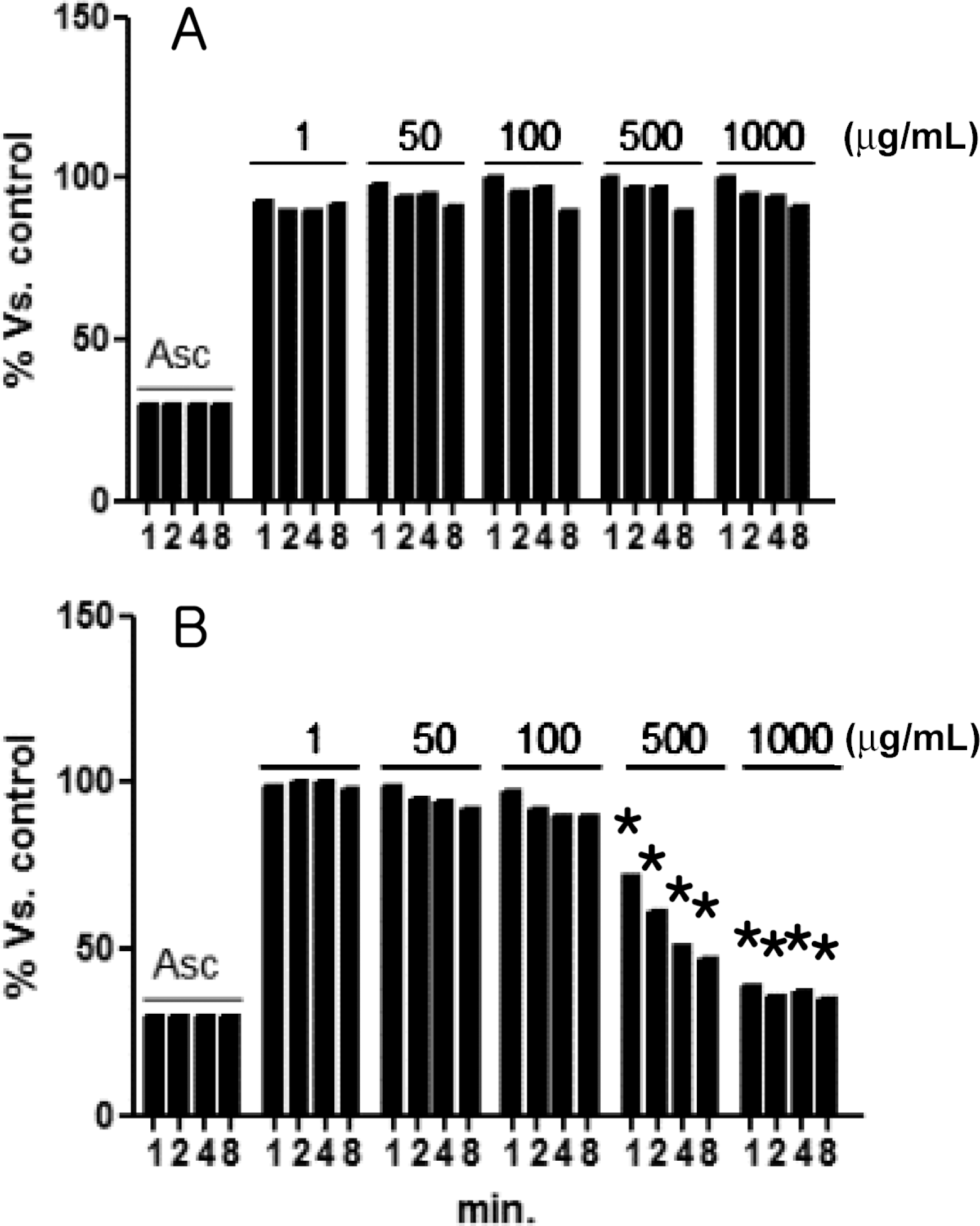
Figure 2.
2,2'-Azinobis-(3-ethyl-benzothiazoline-6-sulfonic acid) (ABTS)-scavenging activities of persimmon flesh extract (PFE) and persimmon calyx extract (PCE). Asc: ascorbic acid (50 µM). ∗Significantly different from vehicle control (100%) (P<0.05).
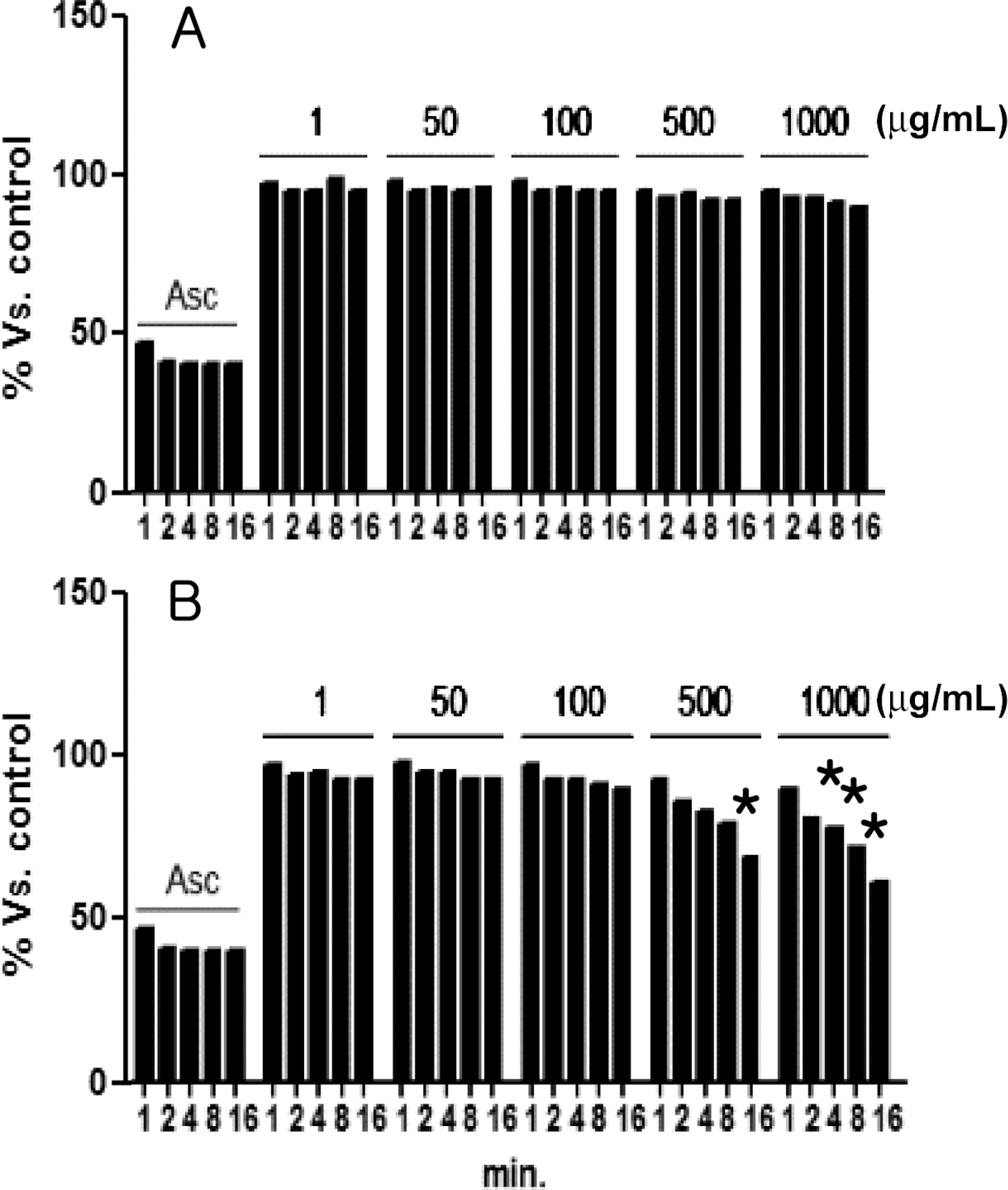
Figure 3.
Nitric oxide-scavenging activities [% of control (100%)] of persimmon flesh extract (PFE) and persimmon calyx extract (PCE). Asc: ascorbic acid (50 µM).
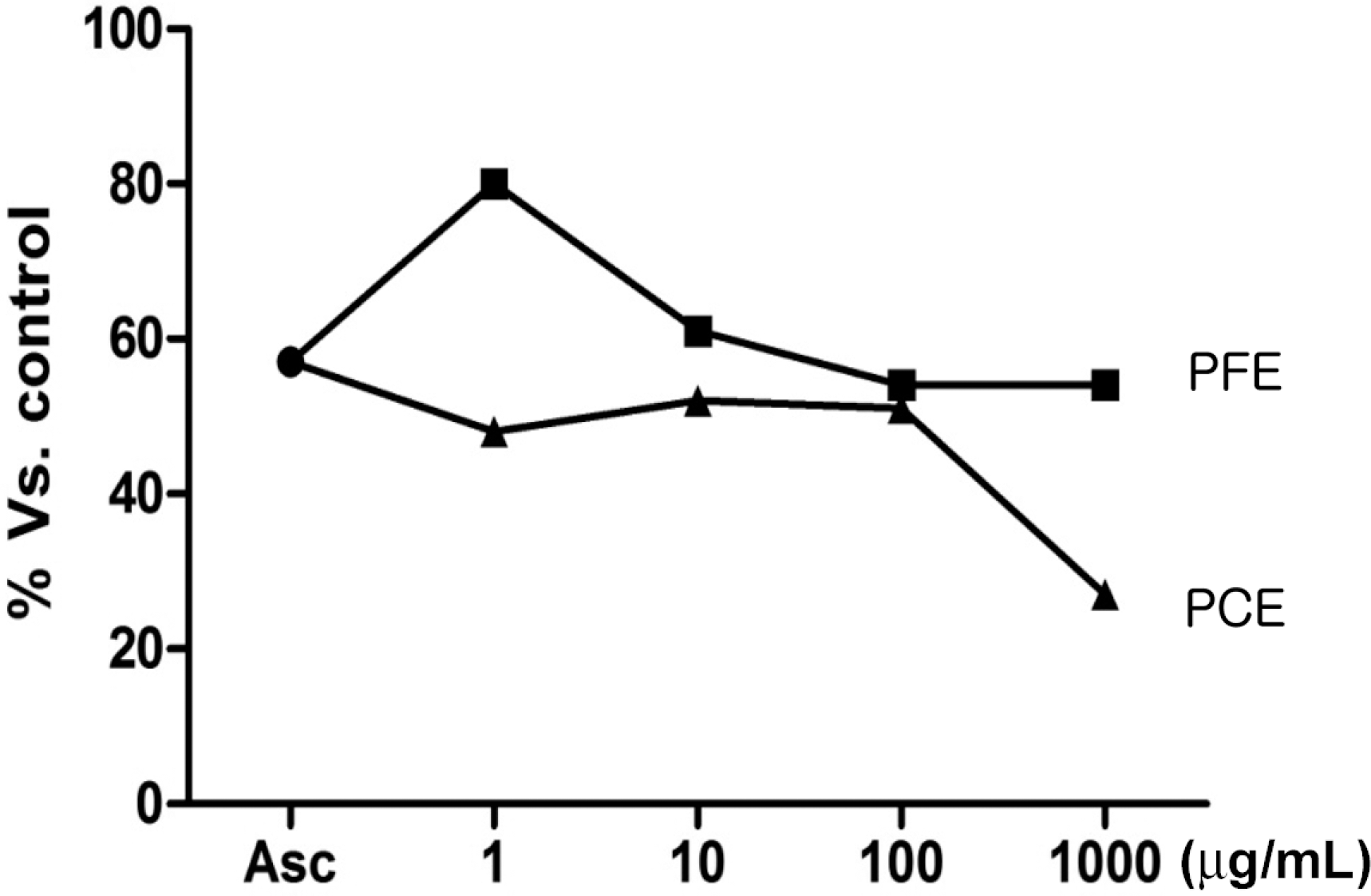
Figure 4.
Inhibitory effects of persimmon flesh extract (PFE) and persimmon calyx extract (PCE) on FeCl3-induced lipid peroxidation. BHT: butylated hydroxytoluene (10 µM). ∗Significantly different from vehicle control (100%) (P<0.05).
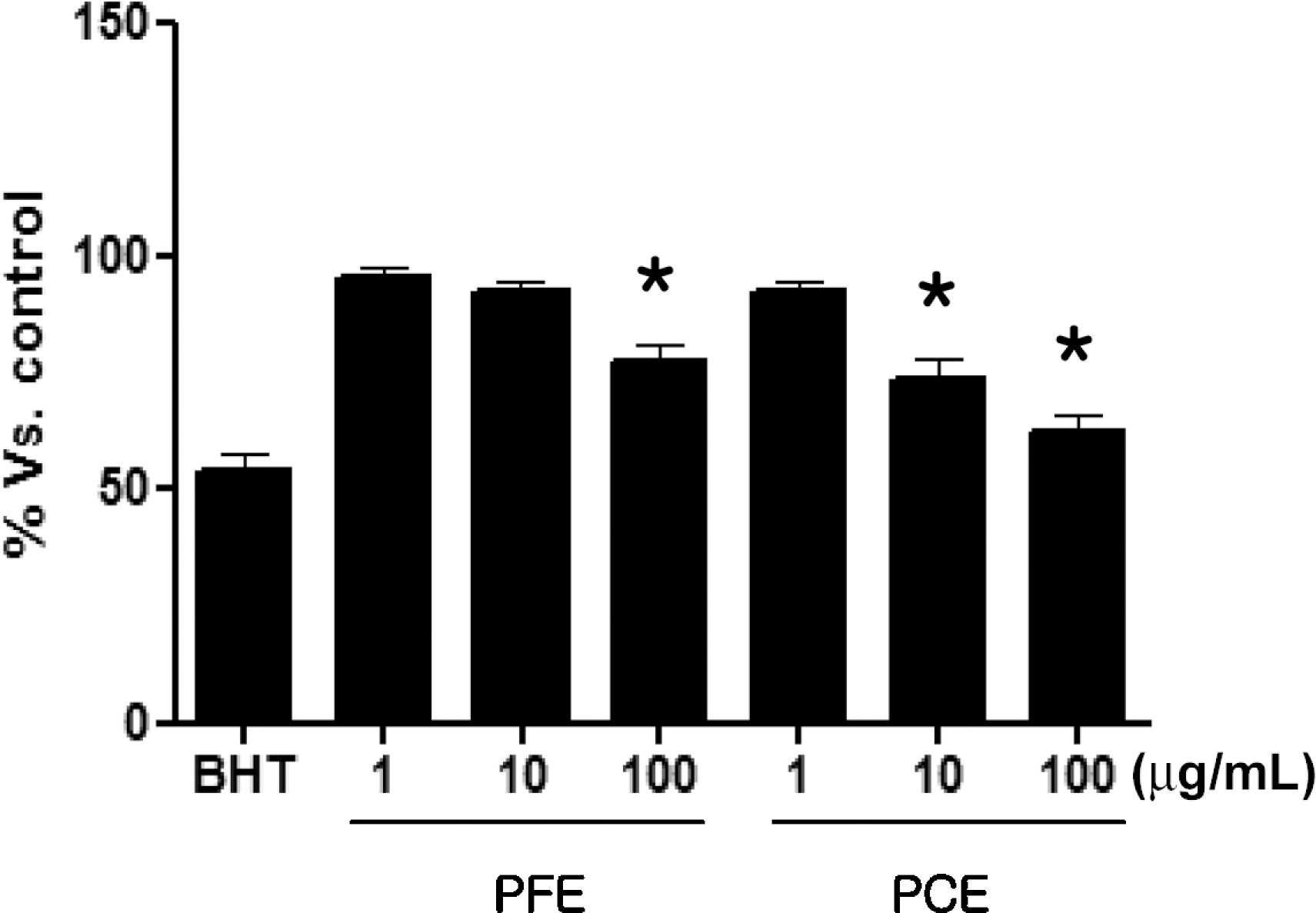




 PDF
PDF ePub
ePub Citation
Citation Print
Print


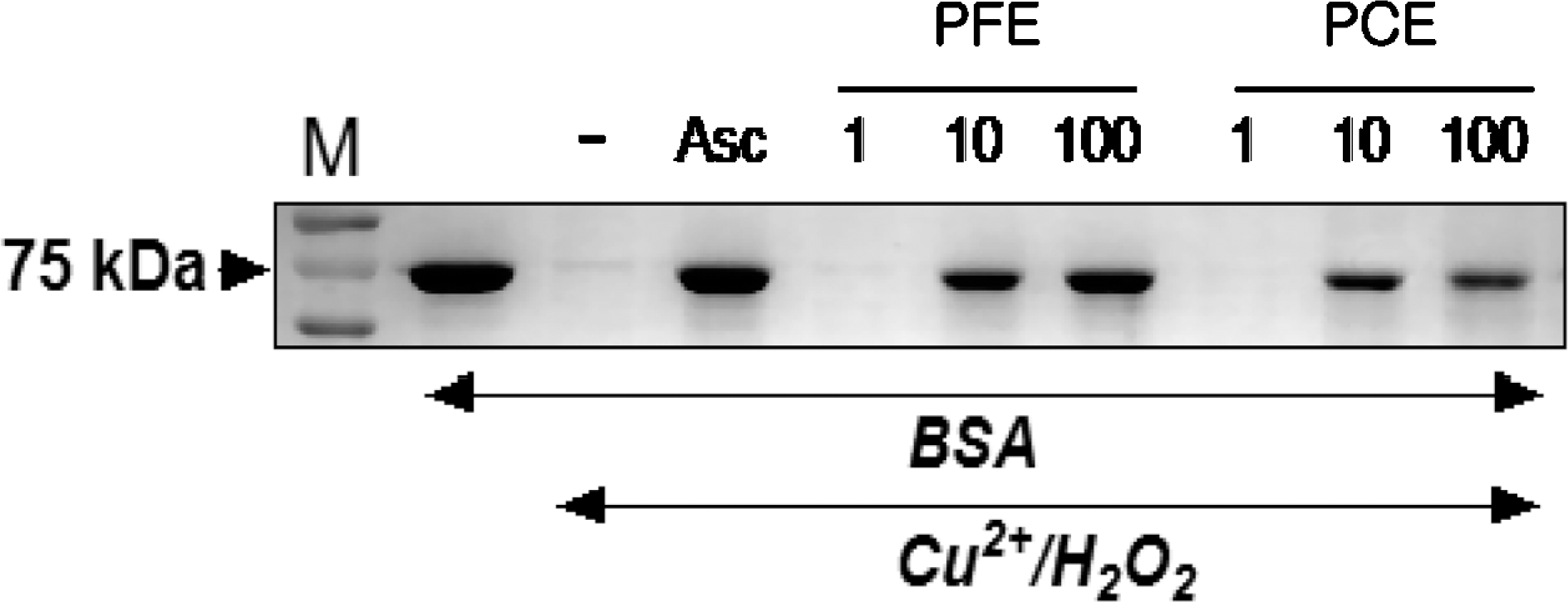
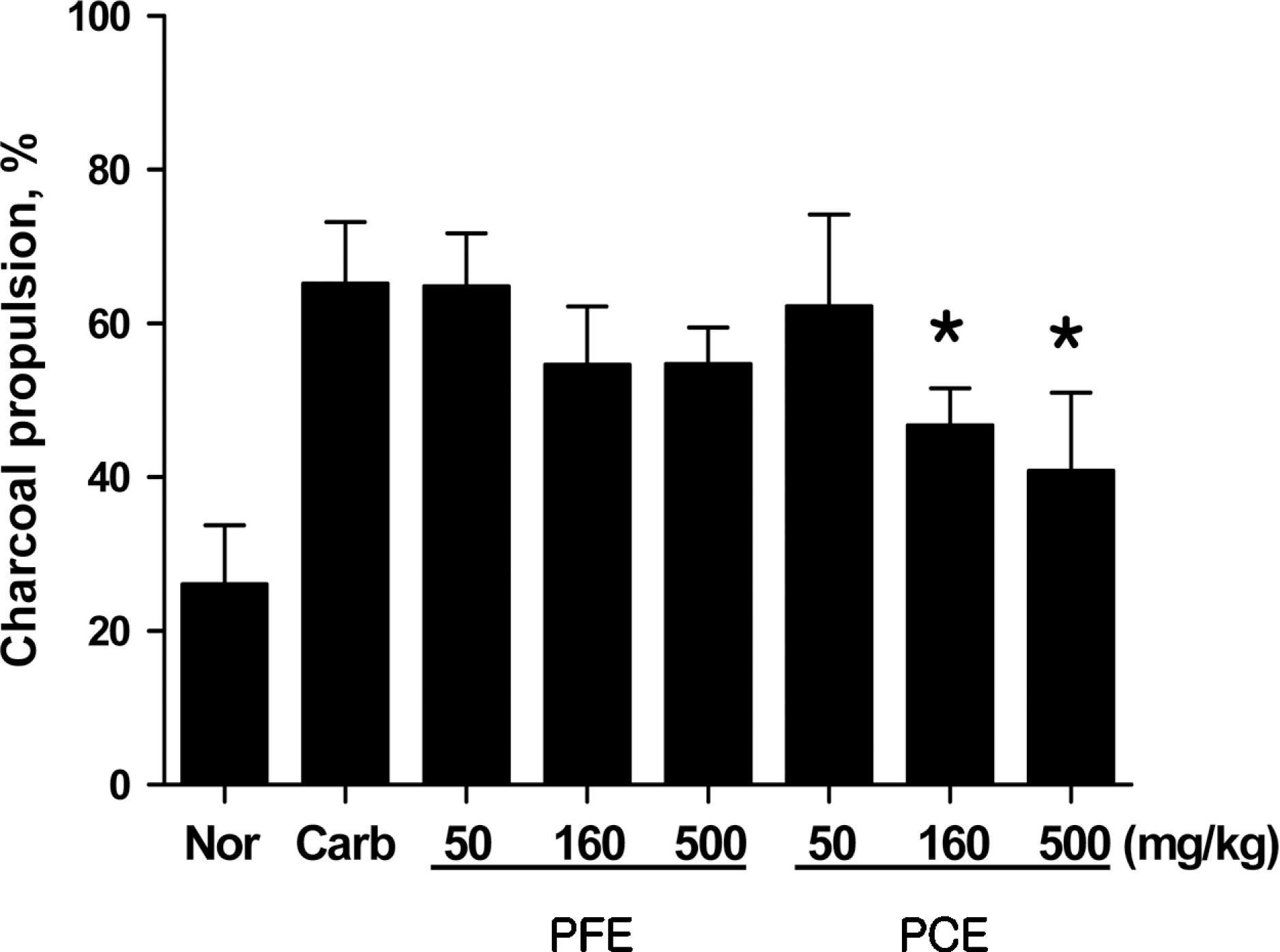
 XML Download
XML Download